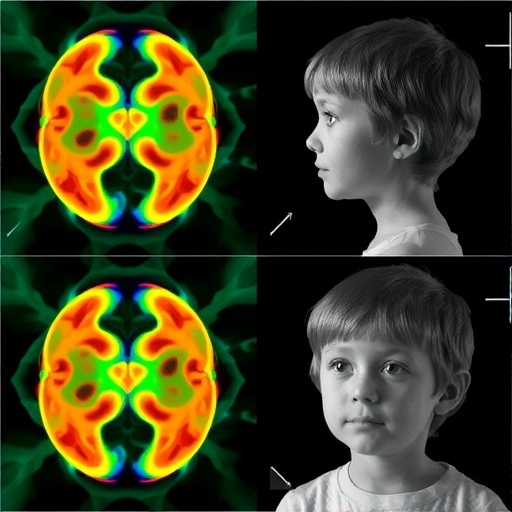A recent groundbreaking study conducted by researchers C. Rothwell, G. Westermann, and C. Hartley sheds light on the intricate dynamics of visual attention during word learning among children. By comparing neurotypical children to their autistic peers, the study ventures into an area that has profound implications for educational strategies and therapeutic approaches aimed at fostering language acquisition. The findings promise to enhance our understanding of how children with diverse developmental profiles engage with language in a visual context.
At the core of this study is the premise that visual attention plays a critical role in the process of learning new words. Previous research has hinted at variances in attention patterns between autistic and neurotypical children; however, this investigation takes a more detailed approach by analyzing how those differences correlate with the accuracy of word learning. The researchers meticulously designed experiments to quantify visual attention as participants engaged in word-learning tasks, thus establishing a robust relationship between attention and language acquisition outcomes.
The methodology employed by Rothwell and colleagues was comprehensive. They created various visual stimuli that were paired with words to observe how children directed their gaze in relation to these cues. By employing eye-tracking technology, the researchers were able to gather precise data on where participants focused their attention during the learning process. This allowed for an in-depth analysis of how visual patterns differed between the two groups, providing empirical evidence that could reshape existing theories surrounding language development in children on the autism spectrum.
An intriguing aspect of the research is its focus on the accuracy of word learning in relation to visual attention. The scientists hypothesized that greater focus on relevant stimuli would correlate with improved word retention. This hypothesis was confirmed through rigorous statistical analysis, revealing that the ability to maintain visual attention on key learning elements significantly impacted the children’s success in acquiring new vocabulary. These findings reinforce the notion that attention is not merely a passive cognitive function but a dynamic mechanism that can facilitate or hinder language development.
Equally compelling was the examination of what types of visual cues captured the attention of both neurotypical and autistic children. The researchers discovered that while both groups displayed preferences for certain types of stimuli, the patterns diverged when it came to more complex images or fast-moving visuals. Autistic children showed a preference for static or simpler images, which points to underlying cognitive processing differences that may influence their learning experiences. This nuance has important implications for educators and practitioners who can tailor visual aids and learning tools to optimize word acquisition for diverse learners.
Moreover, the researchers delved into the implications of their findings for classroom settings. Understanding that autistic children may require different visual strategies can help educators create environments that minimize distractions and enhance focus during word-learning activities. By integrating more structured visual supports and recognizing individual attention patterns, classrooms can become more inclusive spaces where all children have the opportunity to thrive linguistically.
The conversation around inclusive education is timely, with growing recognition that children with different neurodevelopmental profiles learn in distinct ways. This study not only adds empirical weight to this dialogue but also serves to advocate for more personalized educational approaches. As more data emerges, there is a paramount need for teacher training focused on these differences, enabling educators to adapt their teaching methods and materials to cater to the unique needs of each child in their classroom.
Furthermore, the implications extend beyond the classroom. Community programs, parental guidance, and therapeutic interventions can be informed by these findings. For instance, speech-language pathologists can utilize tailored strategies that consider the distinct visual attention patterns of autistic children when designing interventions aimed at improving language skills. This can lead to more effective therapy practices that address the specific challenges faced by these individuals.
Future research avenues suggested by this study include exploring the neural mechanisms underlying the observed attention differences. Understanding the neurological basis for why these attentional variances exist could lead to targeted interventions that aim for cognitive remediation or enhancement in language learning contexts, potentially reshaping approaches in both clinical and educational frameworks.
As awareness of autism spectrum disorders continues to grow, the need for research that elucidates the unique learning profiles of these individuals becomes increasingly pressing. Rothwell, Westermann, and Hartley’s study stands as a vital contribution to this ongoing exploration, inviting educators, clinicians, and families to reconsider existing paradigms and embrace a more nuanced understanding of language acquisition in children.
In conclusion, this investigation highlights the significant role of visual attention in the word-learning processes of autistic and neurotypical children. By providing a detailed analysis of how attention correlates with learning outcomes, the research opens new pathways for enhancing educational strategies tailored to children’s varying developmental needs. The hope is that with further exploration and more widespread application of these findings, we can create a more equitable landscape for language learning, fueling opportunities for all children to succeed.
As the academic community rallies around this promising area of research, the insights gleaned will hopefully spark future studies aimed at further deciphering the complexities of language acquisition across the spectrum of neurodiversity. With ongoing dialogue and commitment to understanding these differences, we stand on the cusp of revolutionary advancements in how we educate and support the next generation of learners.
Subject of Research: Visual Attention Differences and Relationships with Accuracy During Word Learning
Article Title: Investigating Visual Attention Differences and Relationships with Accuracy During Word Learning in Autistic and Neurotypical Children
Article References:
Rothwell, C., Westermann, G. & Hartley, C. Investigating Visual Attention Differences and Relationships with Accuracy During Word Learning in Autistic and Neurotypical Children. J Autism Dev Disord (2025). https://doi.org/10.1007/s10803-025-06993-8
Image Credits: AI Generated
DOI: 10.1007/s10803-025-06993-8
Keywords: Visual Attention, Word Learning, Autism, Neurotypical Children, Language Acquisition, Educational Strategies, Cognitive Processing.




